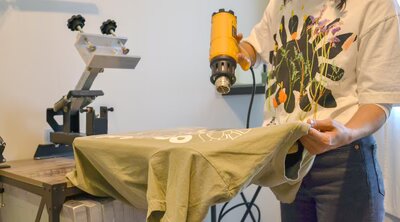Screen printing is a way of making beautiful and striking artwork on your chosen surface. As the printing industry is blooming day by day, more people are becoming aware of the various ways of screen printing. Both methods have their own importance and benefits. So, choosing the right one according to your needs is essential. This blog will examine heat transfer vs screen printing, and provide you insights on which is the best technique for screen printing.
What is Screen Printing?
Screen printing is an outstanding traditional method of printing that produces high-quality prints. This method is processed by pressing ink from a screen with the help of a squeegee onto the surface. Creating the design of image with the help of a stencil.
The number of screens required depends on the number of colors given in the design. The greater the number of colors, the more screens will be used, as each color uses its own screen. This method requires specialized equipment. It’s a pocket-friendly option for many orders.
What is Heat transfer? Heat transfer is a trending method of screen printing, alternatively known as digital transfer. This method is more complex and requires chemical products and complicated equipment. This process works faster than screen printing. It’s an easy and quick way to print designs onto clothes. This process requires a heat presser to transfer heat. The heat presser prints your design onto the paper, and then the ink is transferred thermally from your paper to the fabric with the help of heat and pressure.
Heat transfer vs screen printing: Focus Points
-
Cost Efficiency
The Screen-printing method requires high set-up costs. It is not convenient for small-scale businesses. This technique is reliable for large scale businesses only. On the other hand, the heat press method has proved a better and more efficient alternative for small-scale business.
-
Durability
Screen printing method is more durable because, in this technique, ink is directly soaked into the fabric’s fiber, which makes cloth more durable. On the other side heat press technique uses vinyl which forms another layer over the fabric and the ink doesn’t get absorbed in the fabric of the cloth.
-
Color Accuracy and Vibrancy
Color and vibrancy are other significant factors that decide the quality of a product. In the heat press technique accuracy of colors can be ensured because there is no bonding of color and the fabric of the cloth. However, on the other hand, screen printing poses inaccuracy and vividness to a few shades of color, making the color look vivid on the fabric.
-
Design Complexity
The heat press method of printing is not bound by using a limited number of shades. The heat press technique can produce any complex design with different shades of colors as it prints the design over the vinyl. On the other hand, screen printing can produce complex designs depending on the budget you are spending. Most of the time, a primary screen-printing machine is used, which consists of only 3-4 screens. It allows 3 shades of color at a time.
-
Scale of production
The screen-printing technique is compatible with many orders. As there are only a few steps involved in the process, once all the equipment is installed, using screen printing, an average of a hundred units can be produced within an hour. However, the heat press technique is convenient for a small number of orders, and even if you have the best quality equipment, you can produce only one order at a time.
-
Breathability
Breathability refers to the customer’s experience of cloth, how soft and comfortable the cloth is after printing. The screen-printing technique completes printing by soaking the colors into the fabric’s fiber, which leaves the material soft and easy to wear. In the heat press technique, the cloth doesn’t remain breathable because, in this technique, another layer is created on which printing is done. Which makes the fabric uneasy and uncomfortable to wear.
In a Conslusion
However, both heat transfer vs screen printing techniques have their own pros and cons. It depends upon your need and usage. If you want more vibrant and accurate colors, you must use the heat press technique. However, if you want to proceed with a more durable and pocket-friendly method of screen-printing it will be convenient for you. Which is the better option for screen printing? This all depends on your needs and usage.
Originally Published on screenprintdirect.com


